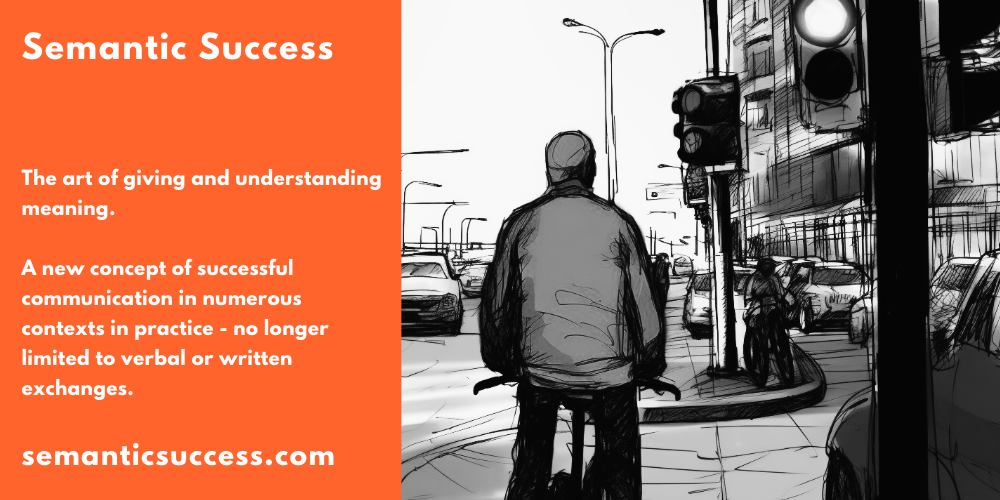What is Successful Communication?
- What is Successful Communication?
- If we commit on this shortest definition of semantic interaction – Communication takes place when a signal is interpreted identically by at least two entities – what can these 2 entities be?
- What other 2 entities can we think about in the context of successful semantics?
- Successful Communication Beyond Traditional Communication Models
Shortest Definition of communication:
Communication takes place when a signal is interpreted identically by at least two entities.
This facet of Semantic Success primarily deals with ensuring that the meaning and intention behind any given message is comprehensively and accurately received by the recipient. It acknowledges that communication is more than the simple transmission of information, but a nuanced exchange where the integrity of the original message must be preserved. Semantic Success in this context entails overcoming the barriers that typically distort, dilute or alter the essence of the communication, thereby leading to more effective interpersonal exchanges.
If we commit on this shortest definition of semantic interaction – Communication takes place when a signal is interpreted identically by at least two entities – what can these 2 entities be?
Two entities can be, for example, two people who agree to meet at a certain time in a certain place. If both arrive at the same place at the same time, then successful communication has taken place.
What other 2 entities can we think about in the context of successful semantics?

Other two entities can be a human being and a red traffic light. If the human being stopped and waited in front of the red traffic light, successful communication has taken place.
In the context of successful semantics, communication isn’t limited to human interactions but expands to include a wide range of entities:
- Computer Systems: Two computer systems or servers exchanging data over a network. If they successfully transmit, receive, and correctly interpret the data, successful communication has occurred.
- Human and Mobile Device: When a person inputs a command on their smartphone (e.g., to open an app) and the phone executes the command correctly, successful communication has taken place.
- Speaker and Audience: In a public speech, if the audience comprehends the message that the speaker is trying to convey, this signifies successful communication.
- Writer and Reader: In a literary context, when a reader correctly interprets the themes, plots, and characters a writer presents in a novel or story, successful communication has happened.
- Teacher and Student: When a teacher explains a concept and the student comprehends and applies it accurately, this denotes successful communication.
- Doctor and Patient: If a patient correctly follows the medical advice or prescription given by a doctor, successful communication has taken place.
- Retailer and Consumer: When a consumer reads a product description and understands accurately the features, benefits, and usage of the product, successful communication has occurred.
- Company and Shareholder: In a business context, if a company shares a financial report and the shareholder interprets it accurately, successful communication has been achieved.
- Musician and Listener: When a musician performs a piece and the listener correctly grasps the emotion or story the musician wants to express, successful communication has taken place.
- Machine Learning Model and Programmer: In a machine learning setting, if a model correctly performs the task it was programmed to do based on the input data, successful communication has occurred.
- Each of these examples illustrates the broad range of potential “entities” in communication, highlighting the universal importance of successful semantics across diverse contexts.
Successful Communication Beyond Traditional Communication Models
- Thermostat and Heating System: In a home, when the room temperature falls below a certain level, a thermostat sends a signal to the heating system to start. Once the room temperature reaches the desired level, the thermostat signals the heating system to stop. This successful communication maintains the temperature of the house.
- GPS and User: When a GPS device or application successfully guides a user to their desired destination based on the provided instructions, successful communication has taken place.
- Plant and Gardener: A plant communicating its needs through physical changes, such as wilted leaves signaling lack of water. If the gardener notices and waters the plant accordingly, successful communication has occurred.
- Autonomous Vehicles: In a self-driving car, if the sensors detect an obstacle and the vehicle’s system responds correctly (e.g., by stopping or swerving), this represents successful communication.
- Pet and Owner: When a pet displays certain behavior (like wagging its tail or whining), it’s attempting to communicate. If the owner understands the meaning and responds appropriately (like petting the dog or feeding it), successful communication has taken place.
- Astronomer and Telescope: When an astronomer adjusts a telescope to observe a celestial body and the telescope provides the desired view, successful communication has occurred.
- Chef and Recipe: When a chef reads a recipe and correctly interprets the steps to create a dish, successful communication has taken place.
- Musician and Instrument: When a musician plays a musical note or chord on an instrument and the instrument produces the desired sound, successful communication has happened.
- Fitness Tracker and User: When a fitness tracker records data (like heart rate or step count) and the user understands this data and adjusts their behavior accordingly, successful communication has occurred.
- Smart Home Devices: If a homeowner uses a smart home app to turn on the lights, and the smart bulb receives the signal and illuminates, successful communication has happened.
These examples show how successful communication can take place in various contexts, not limited to verbal or written exchanges.